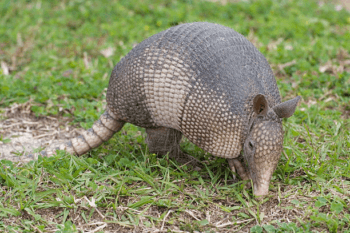Texas A&M Prof Pens New Book About Armadillos

Today’s trivia question, for the luggage and the trip to Paris:
What animal has been around for 55 million years, has remained virtually unchanged in that time, is the only animal that always gives birth to four identical quadruplet offspring, will never win any beauty pageants but is beloved by many for its clumsy and at-times comical mannerisms?
If you answered the armadillo, you can pick up the marbles– and it means you are probably familiar with the mysterious creatures.
Texas A&M University’s Bill Klemm, a professor of neuroscience in the College of Veterinary Medicine & Biomedical Sciences and admitted armadillo fan, has written ‘Dillos: Roadkill on Extinction Highway? and the just-released book contains all you ever wanted to know about armadillos.
“They are strange creatures and fun to study,” Klemm says of his reasons for writing the book. “They are sort of nature’s version of a Bradley tank. You have to give them credit – they are still around after millions of years. You would have to call the armadillo a survivor above all else.”
There are 20 species of armadillos (a Spanish word for “little armored one”) and the nine-banded armadillo – named for the rows of bands around its middle – is the only species seen in Texas. The animals can be found as far north as Kansas and Illinois, but are most frequently seen in the Gulf Coast and Southwest and as far south as Argentina.
Most are about 30 inches in length and weigh from 8-15 pounds, but the giant armadillo of South America can be three times that size. “We have proof that one early ‘dillo species was the size of a black bear. Even so, it is likely that this species, as with all ‘dillo species, are quite harmless and mind their own business.”
Other ‘dillo facts in his book include:
Underwater Ability
Armadillos are adept swimmers and can stay under water for as long as six minutes. “They know how to inflate their stomach with air, so they can stay down a long time,” Klemm points out.
Leprosy
“Armadillos can carry the bacterium that causes leprosy, and for that reason, they have been studied for many years. There have been attempts to make a vaccine from armadillos, but with no success yet. They appear to be partially immune from the disease.”
Jumping Ability
When surprised, armadillos often jump straight up into the air as a defensive maneuver. “But when they cross a road, that often means they jump right into the undercarriage of a car,” Klemm says. “That’s why you see a lot of dead armadillos on the highway,”
Senses
Armadillos have poor vision but are outstanding sniffers. “They can smell insects, even when they are many inches underground. They can go right to a spot and find bugs or worms to eat,” he adds.
Protection
When cornered, armadillos will often curl up into a ball. “They have strong claws they can use, and their armor-like shell gives them great protection from predators. It’s one good reason why they’ve been around for millions of years.”
Like the creatures themselves, armadillos have strange reproduction qualities. Klemm says they always give birth to identical quadruplets, all of the same sex. “They are the only animal that does this, and no one knows why,” he explains.
The animals were often caught and eaten during the Great Depression and were called “Hoover Hogs” after President Herbert Hoover, Klemm notes. They can be trained to use a litter box like a cat, “but they don’t make good pets because they are nocturnal and at night, they will tear up a house rummaging around,” he adds.
The book is written for a general audience, and includes chapters on ‘dillo natural history, the biological features that have enabled them to survive all these millions of years, pop culture, importance in medical research and prospects for future evolution. The species in the U.S. may be in the process of evolving capabilities for survival in colder climates, Klemm believes.
“There’s a reason they’ve been named the official mammal of the state of Texas – it’s because people seem to be fascinated and impressed by them,” Klemm adds. “I’ve written this book because they really are amazing creatures and we need to learn a lot more about them.”
For more information, go to http://dillos.us/
* This link is no longer active and has been removed.
Media contact: Keith Randall, Texas A&M News & Information Services.





